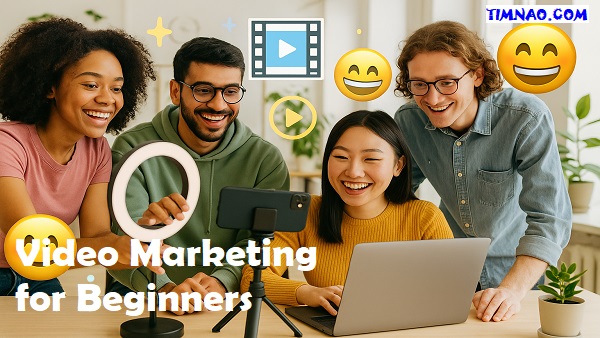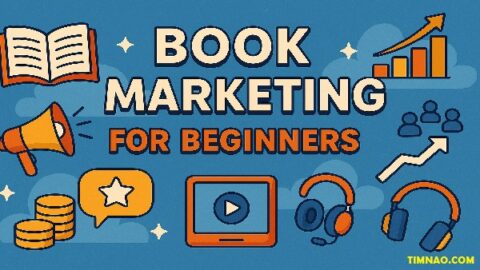🚀 Unlock Astonishing Growth: Your Ultimate Guide to Video Marketing for Beginners!
Welcome to the exciting world of video marketing for beginners! If you’re reading this, you’ve probably sensed the seismic shift in how we consume information and how businesses connect with their audiences. Text and static images still have their place, but video has truly exploded onto the scene, becoming a dominant force in the digital landscape. In 2025, not having a video presence is like a shop hiding its best products in the back room – you’re missing out on incredible opportunities!
Think about your own online habits. How often do you watch videos on platforms like YouTube, TikTok, Instagram Reels, or even LinkedIn? The numbers are staggering. Cisco projects that by 2022, over 82% of all consumer internet traffic would be video, and this trend has only accelerated. People aren’t just watching cat videos (though those are great too!); they’re learning new skills, researching products, getting entertained, and connecting with brands on a deeper level through video. This dynamic medium offers an unparalleled way to capture attention and convey messages with impact.
The beauty of video is its versatility. It can educate, entertain, inspire, and persuade, all within a few seconds or across a more extended narrative. For anyone looking to make an impact online, whether you’re a small business owner, a budding entrepreneur, an artist, or a content creator, understanding how to leverage video is no longer a luxury – it’s a fundamental skill for growth and connection in our visually driven world. This guide is designed to demystify video marketing and show you how, even as a complete beginner, you can start creating compelling video content.
📝 Table of Contents
- 🤔 Why Every Beginner Should Dive into Video Marketing Now
- 🗺️ Setting the Stage: Planning Your First Successful Video Strategy
- 🎯 Defining Crystal-Clear Goals for Your Videos
- 🧐 Knowing Your Audience: The Key to Connection
- 💰 Budgeting Smartly for Your Video Ventures
- 🎬 Choosing Your Spotlight: Platforms and Video Types That Work
- 📱 Popular Video Platforms and Where Beginners Shine
- 🎞️ Types of Engaging Video Content Beginners Can Create
- 🛠️ Gear Up! Essential Tools and Software for Aspiring Video Creators
- 🤳 Cameras: From Smartphones to Starter Kits
- 🎤 Sounding Great: Audio Basics You Can’t Ignore
- 💡 Lighting Up Your Shots (Without Breaking the Bank!)
- 💻 Easy-to-Use Video Editing Software for Newbies
- ✨ Creating Awesome Videos: Top Tips for Producing Engaging Video Content
- 📜 The Magic of Storytelling in Your Videos
- ⏱️ Keeping it Snappy: The Power of Short-Form Content
- 🎨 Making Your Videos Look Good: Visuals and Branding
- 📣 Don’t Forget the Ask: Crafting Effective Calls to Action
- 🔍 Getting Your Videos Noticed: Simple SEO and Promotion Tactics
- 📈 Basic Video SEO to Boost Discoverability
- 🚀 Sharing Your Masterpieces: Smart Promotion Strategies
- 📊 Tracking Your Triumphs: Understanding Basic Video Analytics
- 🪜 Building Your Audience Journey: A Simple Video Marketing Funnel for Starters
- 🏆 Learning from the Pros: Inspiring Video Marketing Examples
- 🔮 Peeking into Tomorrow: Exciting Future Trends in Video Marketing
- 🚀 Conclusion: Your Adventure in Video Marketing for Beginners Starts Today!
🤔 Why Every Beginner Should Dive into Video Marketing Now
If you’re new to marketing or looking to expand your reach, video marketing for beginners offers some of the most compelling advantages. It might seem daunting at first, but the barriers to entry are lower than ever, and the potential rewards are enormous. Let’s explore why now is the perfect time to jump in and start creating engaging video content.
First off, video is incredibly engaging. It combines visuals, sound, motion, and often emotion, creating a richer experience than text or static images alone. This multi-sensory appeal means people are more likely to pay attention and remember your message. In fact, viewers retain 95% of a message when they watch it in a video, compared to 10% when reading it in text. That’s a massive difference in impact!
Secondly, video builds trust and connection like no other medium. Seeing a face, hearing a voice, and watching someone demonstrate a product or share a story creates a sense of authenticity. This is crucial for beginners trying to establish credibility and build relationships with their audience. People buy from people they know, like, and trust, and video is a fantastic shortcut to achieving that.
Moreover, search engines and social media platforms love video. Google, which owns YouTube (the world’s second-largest search engine), often prioritizes video content in search results. Social media algorithms also tend to favor video because it keeps users on their platforms longer. This means that by creating videos, you’re inherently boosting your visibility and making it easier for your target audience to find you. This is a cornerstone of any successful video strategy.
Finally, the tools and technology to create good-quality video are more accessible and affordable than ever. Your smartphone likely has a fantastic camera, and there are plenty of free or low-cost editing apps available. You don’t need a Hollywood budget to start making effective videos. The focus should be on authenticity and providing value to your audience.
🗺️ Setting the Stage: Planning Your First Successful Video Strategy
Before you even think about hitting the record button, a little bit of planning can go a long way in ensuring your video marketing for beginners efforts are effective. A successful video strategy doesn’t need to be complicated, but it does need to be thoughtful. It’s about knowing what you want to achieve, who you’re talking to, and what resources you have.
🎯 Defining Crystal-Clear Goals for Your Videos
What do you want your videos to do for you? This is the first and most crucial question. Without clear objectives, you’ll be shooting in the dark. Common goals for video marketing include:
- Increasing brand awareness: Getting your name and message out to a wider audience.
- Driving traffic to your website: Encouraging viewers to visit your site to learn more or make a purchase.
- Generating leads: Capturing contact information from potential customers.
- Boosting sales: Directly showcasing products or services to encourage purchases.
- Educating your audience: Providing valuable information or tutorials related to your niche.
- Building a community: Fostering engagement and loyalty around your brand.
Try to make your goals SMART: Specific, Measurable, Achievable, Relevant, and Time-bound. For example, instead of “get more views,” a SMART goal might be “increase YouTube video views by 20% in the next three months by publishing two new videos per week.”
🧐 Knowing Your Audience: The Key to Connection
Once you know what you want to achieve, you need to understand who you’re trying to reach. Creating engaging video content is all about resonating with your specific audience. Ask yourself:
- Who are they? (Demographics: age, gender, location, occupation, etc.)
- What are their interests and hobbies?
- What are their pain points or problems that you can help solve?
- What kind of content do they already consume?
- Where do they spend their time online? (Which social media platforms, websites, etc.)
Creating simple “buyer personas” or “audience profiles” can be incredibly helpful here. When you understand your audience deeply, you can tailor your video style, tone, topics, and even the platforms you use to ensure your message hits home.
💰 Budgeting Smartly for Your Video Ventures
Video production can range from virtually free (using your smartphone and free editing software) to very expensive (hiring a professional crew and actors). As a beginner, it’s wise to start lean and scale up as you see results.
Consider potential costs:
- Equipment: While your phone is a great start, you might eventually invest in a better microphone, basic lighting, or a tripod.
- Software: Many good free editing tools exist, but some paid options offer more features.
- Stock footage/music: If you need professional-looking B-roll or background music, there are both free and paid libraries.
- Advertising: If you plan to promote your videos through paid ads, factor that into your budget.
The key is to allocate your budget based on your goals and expected return. Don’t feel pressured to spend a lot initially. Focus on creating valuable content consistently, and you can always upgrade your setup later. Many successful creators started with minimal gear, proving that content is king.
🎬 Choosing Your Spotlight: Platforms and Video Types That Work
With your initial strategy in place, it’s time to think about where your videos will live and what kind of videos you’ll create. Choosing the right platforms and formats is essential for reaching your target audience and creating engaging video content as part of your video marketing for beginners journey.
📱 Popular Video Platforms and Where Beginners Shine
Not all video platforms are created equal, and each has its own audience, style, and strengths. Here are a few popular options for beginners:
- YouTube: The undisputed king of video. It’s a search engine, a social platform, and a place for all types of content, from short tutorials to long-form documentaries. Great for building a library of evergreen content and reaching a broad audience. SEO is crucial here.
- Instagram (Reels & Stories): Highly visual and fantastic for short, engaging videos. Reels are perfect for trending content, behind-the-scenes glimpses, and quick tips. Stories offer a more informal, ephemeral way to connect daily.
- TikTok: The home of short-form, creative, and often viral video content. It’s particularly popular with younger audiences but is expanding. If you can tap into trends and create fun, authentic videos, TikTok can offer massive reach.
- Facebook: Still a powerhouse with a massive user base spanning various demographics. Good for sharing videos with your existing community, running targeted ads, and live streaming. Native Facebook videos tend to perform better than sharing YouTube links.
- LinkedIn: The professional network. Ideal for B2B video marketing, thought leadership, industry insights, company culture showcases, and product demos for a business audience. Videos here tend to be more polished and informative.
- Your Website: Don’t forget to host videos directly on your website! This is great for product pages, landing pages (videos here can boost conversion rates significantly!), and blog posts.
As a beginner, it’s usually best to start with one or two platforms where your target audience is most active. Master those before trying to be everywhere.
🎞️ Types of Engaging Video Content Beginners Can Create
The type of video you create should align with your goals and your audience’s interests. Here are some ideas that are very accessible for beginners:
- Explainer Videos: Short, animated, or live-action videos that explain what your product, service, or concept is all about. Keep them concise and focused on the benefits.
- How-To Videos/Tutorials: Incredibly popular on YouTube. Teach your audience something valuable related to your niche. This positions you as an expert and provides real utility.
- Product Demonstration Videos: Show your product in action! Highlight its features and benefits, and answer common questions. This is much more engaging than just a list of features.
- Customer Testimonial Videos: Let your happy customers do the talking. Short video testimonials build immense trust and social proof.
- Behind-the-Scenes (BTS) Videos: Show the human side of your brand or creative process. BTS content builds authenticity and connection.
- Q&A Videos / Ask Me Anything (AMA): Answer common questions from your audience. This is a great way to engage directly and provide value.
- Listicle Videos: “Top 5 Tips for X,” “3 Mistakes to Avoid When Y.” These are easy to digest and share.
- Short Social Media Clips: Repurpose longer content into bite-sized clips for platforms like Instagram Reels or TikTok. Think quick tips, inspiring quotes, or funny moments.
Don’t be afraid to experiment! See what resonates with your audience by trying different formats. The key is to provide value consistently.
🛠️ Gear Up! Essential Tools and Software for Aspiring Video Creators
One of the biggest myths in video marketing for beginners is that you need expensive, professional-grade equipment to create engaging video content. While high-end gear can certainly enhance quality, you can achieve fantastic results with surprisingly affordable (or even free!) tools. Let’s break down the essentials for getting started.
🤳 Cameras: From Smartphones to Starter Kits
- Your Smartphone: Seriously, the camera on your modern smartphone (iPhone, Android) is likely more than capable of shooting high-quality video, especially for online content. They are convenient, portable, and you already own one! Learn to use its features, like locking focus and exposure.
- Webcams: If you’re doing a lot of talking head videos, tutorials from your computer, or live streams, a good external webcam (like a Logitech C920 or newer) will offer a significant improvement over your laptop’s built-in camera.
- Action Cameras (e.g., GoPro): If your content involves movement, sports, or unique angles, an action camera can be a durable and versatile option.
- Entry-Level Mirrorless or DSLR Cameras: If you’re ready to invest a bit more for greater control and image quality, look into beginner-friendly mirrorless cameras (e.g., Sony ZV-E10, Canon EOS M50 Mark II) or DSLRs. These offer interchangeable lenses and manual settings but come with a steeper learning curve. For now, your phone is probably enough!
Key Tip: Stable footage is crucial! Even a cheap tripod or a makeshift stand (like a stack of books) will make your videos look much more professional than shaky, handheld shots.
🎤 Sounding Great: Audio Basics You Can’t Ignore
Bad audio can ruin an otherwise great video. Viewers are often more forgiving of slightly lower video quality than they are of poor, hard-to-understand sound.
- Your Smartphone’s Microphone (with caveats): In a quiet environment, your phone’s built-in mic can work for close-up shots. However, it picks up a lot of background noise.
- Earbuds/Headphones with a Mic: The microphone on your wired or wireless earbuds is often better than your phone’s or laptop’s built-in mic for voice.
- Lavalier Microphones (Lapel Mics): These small, clip-on mics are affordable and make a huge difference for talking head videos or interviews. You can get wired versions that plug directly into your phone or camera, or wireless systems for more freedom. Brands like Boya or Rode offer good entry-level options.
- USB Microphones: If you’re recording voiceovers or videos at your desk, a USB microphone (e.g., Blue Yeti, Rode NT-USB Mini) will provide excellent audio quality.
Key Tip: Record in a quiet space. Turn off fans, air conditioners, and move away from distracting noises. Soft furnishings like carpets, curtains, and sofas can help reduce echo.
💡 Lighting Up Your Shots (Without Breaking the Bank!)
Good lighting makes you and your subject look better and gives your video a more professional feel.
- Natural Light: Your best friend and it’s free! Position yourself facing a window (but not in direct, harsh sunlight). Avoid having a bright window behind you, as it will make you look like a silhouette.
- Ring Lights: Popular and affordable, ring lights provide even, flattering light for talking head videos, tutorials, and beauty content. Many can be powered by USB.
- Softbox Lights: For a bit more investment, a basic softbox kit (often including two lights with stands) can give you soft, diffused lighting that reduces harsh shadows. Neewer makes affordable kits.
- LED Panels: Portable and versatile, small LED panels can be mounted on your camera or a small tripod to add fill light.
Key Tip: Aim for what’s called “three-point lighting” if you can: a key light (main light), a fill light (softer, to fill in shadows), and a backlight (to separate you from the background). But even one good light source, like a window or a ring light, is a great start.
💻 Easy-to-Use Video Editing Software for Newbies
Editing is where you assemble your footage, add text, graphics, music, and polish your video.
- Mobile Editing Apps:
- CapCut (iOS, Android, Desktop): Free, incredibly popular, and packed with features. Great for social media videos.
- InShot (iOS, Android): Another user-friendly mobile editor with lots of effects and music options.
- VN Video Editor (iOS, Android, Desktop): Free and offers a good range of tools without watermarks.
- Desktop Editing Software (Beginner-Friendly):
- DaVinci Resolve (Windows, Mac, Linux): Amazingly powerful and FREE. It has a bit of a learning curve but offers professional-grade tools. Plenty of tutorials are available online.
- OpenShot (Windows, Mac, Linux): Free, open-source, and relatively easy to learn for basic editing.
- iMovie (Mac): Free and pre-installed on Macs. Very intuitive for beginners.
- Clipchamp (Windows, Web): Now part of Microsoft, it offers a free tier and is integrated into Windows 11. Easy to use for basic edits and has stock media options.
- Paid (but powerful and often worth it later):
- Adobe Premiere Pro: Industry standard, subscription-based. Very powerful but can be overwhelming for absolute beginners.
- Final Cut Pro (Mac): One-time purchase, powerful and popular among Mac users.
Key Tip: Start simple! Learn the basics: cutting clips, adding text, adjusting audio levels, and adding simple transitions. Don’t get bogged down trying to use every fancy effect right away. Consistent, clean edits are more important.
✨ Creating Awesome Videos: Top Tips for Producing Engaging Video Content
Now that you’ve got your plan and your gear (even if it’s just your smartphone!), it’s time for the fun part: creating engaging video content. This is where your creativity comes into play. Here are some crucial tips to help your video marketing for beginners efforts shine and keep your audience hooked.
📜 The Magic of Storytelling in Your Videos
Humans are wired for stories. Whether you’re explaining a complex topic, showcasing a product, or sharing a personal journey, framing it as a story will make it far more memorable and impactful. A good story has:
- A Relatable Character: This could be you, your customer, or even your brand personified.
- A Conflict or Problem: What challenge is the character facing? What question needs answering?
- A Journey or Process: How does the character try to overcome the conflict?
- A Resolution or Transformation: What is the outcome? What was learned?
Even a simple “how-to” video can have a story. The “character” is the viewer, the “conflict” is not knowing how to do something, the “journey” is your tutorial, and the “resolution” is them successfully learning the skill. Think about the emotional journey you want to take your viewers on.
⏱️ Keeping it Snappy: The Power of Short-Form Content
Attention spans are shorter than ever, especially online. While longer videos have their place (like in-depth tutorials on YouTube), much of the engaging video content you create, particularly for social media, should be concise.
- Get to the Point Quickly: The first few seconds are crucial. Hook your viewers immediately and let them know what the video is about and why they should keep watching.
- Edit Ruthlessly: Cut out any fluff, long pauses, or unnecessary information. Keep the pace brisk.
- Consider Platform Norms: TikToks and Instagram Reels are typically under 60 seconds, often much shorter. Facebook and YouTube can accommodate longer videos, but still, ensure every minute serves a purpose.
Even if you’re creating a longer video for YouTube, consider breaking down key points into shorter, digestible segments within the video, using visual cues or on-screen text to highlight them.
🎨 Making Your Videos Look Good: Visuals and Branding
While content is king, visual appeal matters. You don’t need to be a professional cinematographer, but a few simple touches can elevate your videos:
- Good Framing and Composition: Learn the “rule of thirds” – imagine your screen is divided into a 3×3 grid, and place key elements along those lines or at their intersections. Ensure your subject is well-lit and in focus.
- Clean Backgrounds: A cluttered or distracting background can take attention away from your message. Choose a simple, tidy background. A plain wall, a bookshelf, or even a blurred background (achievable with some phone camera modes or editing software) can work well.
- Consistent Branding (if applicable): If you’re creating videos for a business, incorporate your brand colors, logo (subtly!), and fonts in your video graphics, thumbnails, and end screens. This helps with brand recognition.
- Engaging Thumbnails: For platforms like YouTube, the thumbnail is like a mini-movie poster. It needs to be eye-catching, accurately represent the video’s content, and encourage clicks. Use clear, high-quality images, bold text, and consider including a face if appropriate.
📣 Don’t Forget the Ask: Crafting Effective Calls to Action (CTAs)
What do you want viewers to do after watching your video? Don’t assume they’ll know. You need to tell them! This is your Call to Action. Your CTA should be clear, concise, and relevant to the video’s content and your goals.
Examples of CTAs:
- “Subscribe to my channel for more videos like this!”
- “Visit the link in the description to download your free guide.”
- “Leave a comment below and let me know what you think.”
- “Share this video with a friend who might find it helpful.”
- “Click here to shop the product featured in this video.”
You can include CTAs verbally in your video, as on-screen text, in your video description, or as clickable end screens or cards (on YouTube). Don’t overdo it with too many CTAs in one video – focus on the most important action.
🔍 Getting Your Videos Noticed: Simple SEO and Promotion Tactics
Creating fantastic, engaging video content is a huge achievement, but it’s only half the battle in your video marketing for beginners journey. If no one sees your videos, they can’t have an impact. This is where basic video Search Engine Optimization (SEO) and smart promotion strategies come in.
📈 Basic Video SEO to Boost Discoverability
SEO isn’t just for websites; it’s crucial for videos too, especially on platforms like YouTube. Here’s how to help search engines (and people!) find your videos:
- Keyword Research: Think about what terms people would type into a search bar to find content like yours. Use tools like Google Keyword Planner (free), TubeBuddy, or VidIQ (both have free and paid versions) to find relevant keywords. Look at what keywords your competitors are using.
- Compelling Video Titles: Your title should be clear, concise (ideally under 60-70 characters to avoid truncation), and include your main keyword, preferably near the beginning. Make it intriguing enough to click.
- Detailed Video Descriptions: Don’t skip the description! Write a detailed summary of your video (a few hundred words is great), naturally incorporating your keywords and related terms. Include a link to your website or other relevant resources. The first few lines are most important as they often show in search results.
- Use Tags/Hashtags:
- YouTube Tags: Add a mix of broad and specific tags relevant to your video’s topic. Include your main keywords, variations, and even competitor channel names (if relevant and ethical in your niche).
- Hashtags (Instagram, TikTok, LinkedIn, etc.): Use relevant hashtags to increase discoverability. Research popular and niche-specific hashtags.
- Create an Eye-Catching Thumbnail: As mentioned before, your thumbnail is critical for click-through rates. Make it high-quality, visually appealing, and clearly related to your video content.
- Add Subtitles/Closed Captions (CC): Uploading accurate captions not only makes your videos accessible to a wider audience (including those with hearing impairments or watching with the sound off) but also gives search engines more text to crawl, potentially boosting your SEO. YouTube’s auto-captions are a start, but always review and edit them for accuracy.
- Organize with Playlists (YouTube): Group related videos into playlists. This encourages binge-watching and helps organize your content for viewers and search engines.
🚀 Sharing Your Masterpieces: Smart Promotion Strategies
Don’t just upload your video and hope for the best. Actively promote it!
- Share on Social Media: Post your video (or a link to it, though native uploads often perform better) on all your relevant social media channels. Tailor the caption for each platform. Use engaging visuals or create short teaser clips.
- Embed on Your Website/Blog: If the video is relevant to a blog post or a page on your website, embed it directly. This adds value to your site and can increase watch time.
- Email Marketing: Share your new videos with your email subscribers. This is a great way to reach an already engaged audience.
- Collaborate with Others: Partner with other creators or businesses in your niche for cross-promotion.
- Engage with Comments: Respond to comments on your videos. This builds community and can encourage more engagement, which platforms often reward with increased visibility.
- Online Communities: Share your video in relevant online forums, Facebook groups, or Reddit communities (but always check the group’s rules about self-promotion first!). Provide context and value, don’t just spam links.
- Consider Paid Promotion (Optional): If you have a budget, you can use platforms like YouTube Ads or Facebook Ads to promote your videos to a targeted audience.
Consistency in creation and promotion is key to building momentum for your successful video strategy.
📊 Tracking Your Triumphs: Understanding Basic Video Analytics
Once your videos are out in the wild and you’re promoting them, how do you know if your video marketing for beginners efforts are actually working? The answer lies in analytics. Most video platforms provide data on how your videos are performing. Understanding these basic metrics is crucial for refining your successful video strategy and creating more engaging video content in the future.
Here are some key metrics to pay attention to:
- View Count: This is the most obvious metric – how many times your video has been watched. While a high view count is nice, it doesn’t tell the whole story.
- Watch Time (or Average View Duration): This is arguably more important than views. It measures the total amount of time people have spent watching your video or, on average, how long each viewer watches. Platforms like YouTube heavily favor videos with high watch time because it means people are engaged and staying on the platform.
- Audience Retention: This shows you what percentage of viewers are still watching at various points throughout your video. It’s often displayed as a graph. Look for sharp drop-off points – this could indicate a part of your video that isn’t engaging or where viewers are losing interest. Understanding this helps you identify what works and what doesn’t in your content.
- Engagement Rate: This includes likes, dislikes (yes, these provide feedback too!), comments, shares, and subscribes (on YouTube). High engagement signals that your content is resonating with viewers and prompting them to interact.
- Click-Through Rate (CTR): This usually refers to how many people click on your video thumbnail to watch it when it appears in search results, suggestions, or on their feed. A low CTR might mean your title or thumbnail isn’t compelling enough. For CTAs within your video (e.g., clicking a link in the description), track how many people take that action.
- Traffic Sources: Where are your viewers coming from? Are they finding your videos through search, suggested videos, social media, or external websites? This helps you understand which promotion channels are most effective.
- Audience Demographics: Most platforms provide data on your viewers’ age, gender, geographic location, and sometimes even interests. This helps you verify if you’re reaching your target audience and allows you to tailor content more effectively.
How to Use This Data:
- Identify Top-Performing Content: Which videos get the most watch time and engagement? Try to understand why and create more content like that.
- Improve Underperforming Content: If videos have low retention or CTR, can you improve the intros, titles, thumbnails, or overall content?
- Optimize for Your Audience: Use demographic and traffic source data to refine your targeting and content strategy.
- Set Benchmarks: Track your metrics over time to see if your efforts are leading to growth.
Don’t get overwhelmed by data. Start by focusing on a few key metrics like watch time, audience retention, and engagement. Regularly checking your analytics (e.g., weekly or monthly) will provide valuable insights for your journey.
🪜 Building Your Audience Journey: A Simple Video Marketing Funnel for Starters
As you delve deeper into video marketing for beginners, you might hear about the “marketing funnel.” It sounds complex, but the basic idea is simple: guiding potential customers through a journey from initially discovering you to eventually taking a desired action (like making a purchase or subscribing). Video is incredibly effective at each stage of this journey.
Here’s a simplified video marketing funnel that beginners can understand and implement:
1. Awareness Stage: “Hello, World! This is Me!”
- Goal: Introduce your brand, product, or service to a wide audience who may not have heard of you before. Attract attention and generate initial interest.
- Types of Videos:
- Short, engaging social media videos (e.g., entertaining clips, quick tips relevant to a broad audience).
- Introductory “About Us” or brand story videos.
- Explainer videos that simplify a common problem your audience faces (without a hard sell).
- Visually appealing videos that are highly shareable.
- Focus: Broad reach, impressions, views, shares. You want to cast a wide net.
2. Consideration Stage: “Hmm, Tell Me More…”
- Goal: Now that people are aware of you, provide them with more detailed information that helps them understand how you can solve their problems or meet their needs. Build trust and position yourself as a valuable resource.
- Types of Videos:
- In-depth product demonstration videos.
- How-to guides and tutorials showcasing your expertise or product features.
- Customer testimonial videos or case studies.
- Comparison videos (e.g., your solution vs. other options, tactfully done).
- Webinar recordings or extended Q&A sessions.
- Focus: Watch time, click-throughs to your website, lead generation (e.g., signing up for a newsletter to get more info).
3. Decision Stage: “Okay, I’m Ready to Choose!”
- Goal: Encourage viewers who are seriously considering your solution to take the final step. Overcome any last-minute objections and make it easy for them to convert.
- Types of Videos:
- Videos highlighting special offers, discounts, or limited-time promotions.
- FAQ videos addressing common concerns before purchase.
- Personalized video messages (if feasible, for high-value leads).
- Clear call-to-action videos guiding them to purchase or sign up.
- Focus: Conversion rates (sales, sign-ups), lead quality.
4. Loyalty Stage (Post-Conversion): “You’re Awesome, Let’s Stay Connected!”
- Goal: Keep your existing customers happy, encourage repeat business, and turn them into advocates for your brand.
- Types of Videos:
- Thank you videos.
- Onboarding videos or advanced tutorials for your product/service.
- Exclusive content for customers (e.g., sneak peeks, special Q&As).
- Videos encouraging user-generated content (e.g., asking customers to share their experiences).
- Focus: Customer retention, repeat purchases, referrals, user engagement.
As a beginner, you might start by focusing on creating videos for the Awareness and Consideration stages. As you grow, you can develop content for the entire funnel. The key is to map your video content to where your audience is in their journey with you.
🏆 Learning from the Pros: Inspiring Video Marketing Examples
Sometimes, the best way to learn is by seeing what works for others. Many brands, big and small, have achieved incredible success with their video marketing. While you’re just starting your video marketing for beginners journey, these examples can provide inspiration for your own successful video strategy and help you think about how to create engaging video content.
-
Dollar Shave Club (Launch Video): This is a classic. Their 2012 launch video was low-budget, hilarious, and directly addressed customer pain points about expensive razors. It went viral, showcasing how humor and a clear value proposition can make a massive impact. Lesson for beginners: You don’t need a huge budget if you have a great idea and understand your audience. Authenticity and relatable humor can win.
-
Blendtec (“Will It Blend?”): This company took a seemingly boring product (blenders) and created a wildly entertaining video series where they blended everything from iPhones to golf balls. It was quirky, memorable, and brilliantly showcased the product’s power. Lesson for beginners: Think outside the box! How can you demonstrate your product’s capabilities in a fun and unexpected way?
-
GoPro (User-Generated Content): GoPro heavily features breathtaking videos shot by its users. This not only provides them with a constant stream of authentic and engaging video content but also builds a strong community around their brand and showcases the product in real-world action. Lesson for beginners: Encourage your audience to share their experiences with your product or service. User-generated content is powerful social proof.
-
Tasty (BuzzFeed): Those overhead recipe videos that are fast-paced, visually appealing, and easy to follow took social media by storm. They are highly shareable and cater to the desire for quick, satisfying content. Lesson for beginners: Identify content formats that are popular on the platforms you’re targeting. Can you adapt your message to a trending style? Keep videos concise and visually engaging.
-
Patagonia (“Worn Wear”): Patagonia often creates mini-documentaries and storytelling videos that focus on environmentalism, sustainability, and the adventures of their customers. These videos align perfectly with their brand values and resonate deeply with their target audience, building emotional connections rather than just selling products. Lesson for beginners: Connect with your audience on a values level. Tell stories that matter to them and reflect what your brand stands for.
-
Khan Academy (Educational Content): Salman Khan started by creating simple video tutorials to help his cousins with math. His clear, straightforward teaching style on a digital blackboard grew into a massive non-profit educational platform. Lesson for beginners: Value is paramount. If you can clearly explain complex topics or teach valuable skills, you can build a loyal audience. Production quality can be simple if the content is excellent.
When looking at these examples, don’t just see the big brands. Notice the underlying principles: understanding the audience, clear messaging, emotional connection, providing value, and choosing the right platform and format. You can apply these principles to your own videos, no matter your budget or niche.
🔮 Peeking into Tomorrow: Exciting Future Trends in Video Marketing
The world of video marketing is constantly evolving. As a beginner, while mastering the fundamentals is key, it’s also exciting to be aware of emerging trends. This can help you future-proof your successful video strategy and find new ways to create engaging video content. Here are some trends shaping the future of video:
-
The Continued Dominance of Short-Form Video: Platforms like TikTok, Instagram Reels, and YouTube Shorts have cemented the popularity of quick, digestible video content. Expect this trend to continue, with brands needing to master the art of storytelling in seconds, not minutes.
- For beginners: Practice creating concise, attention-grabbing videos.
-
Live Streaming for Real-Time Engagement: Live video (on platforms like Instagram Live, Facebook Live, YouTube Live, Twitch, LinkedIn Live) creates an immediate connection with audiences. It’s great for Q&As, behind-the-scenes, product launches, and interactive events. The unscripted nature often feels more authentic.
- For beginners: Consider hosting a simple live Q&A session once you’re comfortable on camera.
-
AI-Powered Video Creation and Personalization: Artificial Intelligence is already playing a role in video editing (e.g., auto-captioning, identifying best clips) and will increasingly be used for creating personalized video content at scale, and even generating video from text prompts (like tools such as Sora by OpenAI, though still developing).
- For beginners: Explore AI-assisted editing tools that can simplify your workflow.
-
Interactive Video Experiences: Videos that allow viewers to click, choose paths, answer questions, or shop directly within the video are becoming more common. This increases engagement and can provide valuable data.
- For beginners: While complex interactivity might be advanced, think about simple ways to encourage interaction, like polls in Instagram Stories or clear on-screen prompts.
-
Augmented Reality (AR) and Virtual Reality (VR) Integration: While still more niche, AR filters (common on Instagram and Snapchat) are a simple form of AR in video. True VR video offers immersive experiences. As technology becomes more accessible, we’ll see more AR/VR in marketing.
- For beginners: Experiment with AR filters on social media if they fit your brand.
-
Shoppable Videos: E-commerce and video are merging. Platforms are making it easier for viewers to purchase products directly from a video. This is particularly relevant for product demonstrations and influencer marketing.
- For beginners: If you sell products, ensure your product links are easily accessible in your video descriptions or bios.
-
Hyper-Personalization: Using data to deliver highly personalized video messages to individual users or small audience segments. This could be personalized product recommendations, welcome videos, or support tutorials.
- For beginners: Focus on understanding your audience segments and tailoring your general messaging to them.
-
Increased Emphasis on Authenticity and Purpose-Driven Content: Audiences, especially younger generations, crave authenticity and connect with brands that stand for something. Slick, overly corporate videos can fall flat. Raw, real, and purpose-driven content often performs better.
- For beginners: Don’t be afraid to be yourself! Authenticity is your superpower.
-
Video SEO Remains Crucial: As more video content is created, optimizing your videos for search engines (on YouTube, Google, and within social platforms) will be even more critical for discoverability.
- For beginners: Master the basics of video SEO covered earlier.
While some of these trends might seem advanced, being aware of them helps you understand the direction video is heading. For now, focus on creating valuable, authentic content for your specific audience using the tools and platforms that make sense for you.
🚀 Conclusion: Your Adventure in Video Marketing for Beginners Starts Today!
You’ve made it through this ultimate guide to video marketing for beginners! We’ve covered a lot, from understanding the immense power of video and planning your successful video strategy, to choosing the right gear, creating engaging video content, promoting it, and even peeking into the future. It might seem like a mountain of information, but remember, every expert was once a beginner.
The most important step you can take now is to start. Don’t aim for perfection right out of the gate. Your first videos won’t be your best, and that’s perfectly okay. The key is to learn by doing, to experiment, to listen to your audience, and to consistently show up and provide value.
Embrace the learning process. Use your smartphone, find a quiet spot, think about a simple message your audience would appreciate, and hit record. Edit it with a free app, share it on one platform, and see what happens. Then, do it again. Each time, you’ll get a little better, a little more confident, and a little closer to achieving your video marketing goals.
Video is an incredibly rewarding medium that allows you to connect with people in a way that text and images simply can’t. It’s your chance to share your passion, your expertise, your story, and your unique voice with the world. The tools are accessible, the audience is ready, and the potential for growth is astonishing. Your adventure in video marketing begins now – go make some magic!
Reference video:









